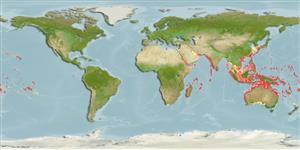Common names from other countries
Environment: milieu / climate zone / depth range / distribution range
Ecologia
marino associati a barriera corallina; non migratori; distribuzione batimetrica 0 - 60 m (Ref. 89972). Tropical; 30°N - 20°S
Indo-Pacific: Red Sea and East Africa (extending to Mossel Bay, South Africa, Ref. 5372) to the Hawaiian, Marquesan, and Ducie islands, north to southern Japan, south to Lord Howe and Rapa islands.
Length at first maturity / Size / Peso / Age
Maturity: Lm 13.0 range ? - ? cm
Max length : 25.0 cm TL maschio/sesso non determinato; (Ref. 129178)
Spine dorsali (totale) : 12 - 13; Raggi dorsali molli (totale) : 22 - 25; Spine anali: 3; Raggi anali molli: 19 - 21.
May be seen in a variety of habitats ranging from rich coral reefs (Ref. 58652) to weedy and rubble covered areas (Ref. 1602). Benthopelagic (Ref. 58302). Maybe found singly, in pairs, and in aggregations that roam over large distances in search of food. Feed mainly by tearing pieces from polychaetes, sea anemones, coral polyps, and algae (Ref. 1602). Oviparous (Ref. 205). Form pairs during breeding (Ref. 205). Minimum depth reported taken from Ref. 128797.
Life cycle and mating behavior
Maturities | Riproduzione | Spawnings | Egg(s) | Fecundities | Larve
Distinct pairing (Ref. 205). Monogamous mating is observed as both obligate and social (Ref. 52884).
Allen, G.R., 1985. Butterfly and angelfishes of the world. Vol. 2. 3rd edit. in English. Mergus Publishers, Melle, Germany. (Ref. 4858)
IUCN Red List Status (Ref. 130435)
CITES (Ref. 128078)
Not Evaluated
Threat to humans
Reports of ciguatera poisoning (Ref. 130160)
Human uses
Pesca: scarso interesse commerciale; Acquario: Commerciale
Strumenti
Special reports
Download XML
Fonti Internet
Estimates based on models
Preferred temperature (Ref.
115969): 25.5 - 29, mean 28 (based on 922 cells).
Phylogenetic diversity index (Ref.
82804): PD
50 = 0.5000 [Uniqueness, from 0.5 = low to 2.0 = high].
Bayesian length-weight: a=0.02512 (0.01625 - 0.03883), b=2.98 (2.85 - 3.11), in cm Total Length, based on LWR estimates for this species & Genus-body shape (Ref.
93245).
Trophic level (Ref.
69278): 3.7 ±0.3 se; based on diet studies.
Resilienza (Ref.
120179): Alto, tempo minimo di raddoppiamento della popolazione meno di 15 mesi (K = 1.5;).
Fishing Vulnerability (Ref.
59153): Low vulnerability (23 of 100).
